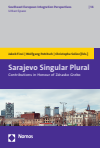Abstract
Sarajevo Singular Plural offers a collection of contributions—essays as well as art and photography portfolios—focusing on Sarajevo as a ‘multiplex city’. The book screens how ‘being with’—at one and the same time co-existence, exposure to each other and hybridisation—is translated into the permanent metamorphosis of a city merging its past and its future. Sarajevo’s recent past contains tragedies, suffering and failures of humanity as well as much unrealised hope and potential. The art and photography portfolios attempt in particular to capture this in delicate and refined ways. The book scrutinises Sarajevo’s urban space from a diversity of standpoints, combining approaches inspired by architecture, urbanism, literature, art, anthropology, history, philosophy, the social sciences and politics. Sarajevo Singular Plural views the city as ceaselessly active and perpetually changing; it presupposes a multidimensional and collaborative system composed of highly reactive projects connecting a wide range of ‘drivers for change’. This volume should not be regarded as a closed and completed whole, a form deposited once and for all, or a totality. It amounts rather to an open site, inviting a further combination of the different contributions, which may be conceived as fragments that elicit different readings of the urban space over time. With contributions by Gordana Anđelić-Galić | Ferida Duraković | Jakob Finci | Yvana Enzler | Selma Harrington | Srdja Hrisafović | Jasmina Husanović | Senka Ibrišimbegović | Milomir Kovačević-Strašni | Anida Krečo | Aleksandra Nina Knežević | Emina Kujundžić | Smirna Kulenović | Larisa Kurtović | Jasmina Memić | Nicolas Moll | Asim Mujkić | Jean-Luc Nancy | Edin Numankadić | Wolfgang Petritsch | Haris Piplaš | Christophe Solioz | Igor Štiks | Nenad Stojanović | Sabina Tanović | Nina Ugljen-Ademović | Kenan Vatrenjak | Mejrema Zatrić | Almin Zrno
Zusammenfassung
Der Band Sarajevo Singular Plural vereint Beiträge zur bosnisch-herzegowinischen Hauptstadt aus multidisziplinärer Perspektive und betrachtet vor allem die Zeit nach dem Zerfall des multinationalen Staates Jugoslawien. Zahlreiche hochwertige künstlerische Bilder geben einen eindrücklichen Einblick in Geschichte und Leben der Stadt Sarajevo. Es wird deutlich, wie sehr sich die Stadt gewandelt hat, wie Vergangenheit und Gegenwart zusammengeführt werden und wie stets der Blick in die Zukunft geworfen wird. Mit Beiträgen von Gordana Anđelić-Galić | Ferida Duraković | Jakob Finci | Yvana Enzler | Selma Harrington | Srdja Hrisafović | Jasmina Husanović | Senka Ibrišimbegović | Milomir Kovačević-Strašni | Anida Krečo | Aleksandra Nina Knežević | Emina Kujundžić | Smirna Kulenović | Larisa Kurtović | Jasmina Memić | Nicolas Moll | Asim Mujkić | Jean-Luc Nancy | Edin Numankadić | Wolfgang Petritsch | Haris Piplaš | Christophe Solioz | Igor Štiks | Nenad Stojanović | Sabina Tanović | Nina Ugljen-Ademović | Kenan Vatrenjak | Mejrema Zatrić | Almin Zrno
Schlagworte
Architecture Bosnia-Herzegovina Croatia Democracy Siege Urban Spaces- 11–20 Sarajevo calling 11–20
- 89–92 Silk and velvet 89–92
- 123–128 Sarajevo downhill 123–128
- 155–176 Sarajevo – neighbours 155–176
- 177–202 Reading Sarajevo City 177–202
- 225–234 Tito Street 225–234
- 257–268 From pain to hope 257–268
- 269–274 Sarajevo as a woman 269–274
- 283–294 Our Family Garden II 283–294
- 325–338 Cities and artists 325–338
- 347–356 Bibliography 347–356
- 357–366 About the Contributors 357–366
- 367–367 Acknowledgements 367–367

